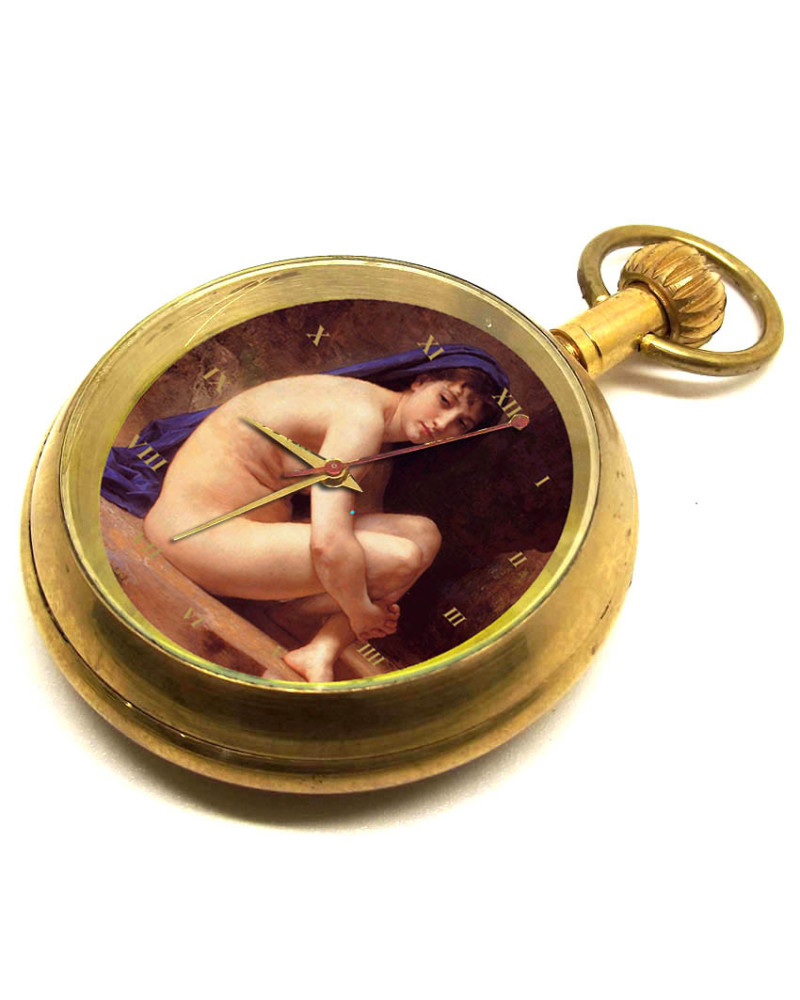




⦿ 50 mm large size heavy brass case with see-through mineral glass back.
⦿ Original 1960s 17-jewel mechanical hand-winding movement.
⦿ Unique collectible limited edition handmade watches with great investment potential.
William-Adolphe Bouguereau (1825–1905) was a French academic painter known for his mastery of classical techniques, meticulous realism, and depictions of the human form, especially the female nude. While his work is often associated with religious, mythological, and pastoral themes, there is a distinct erotic undercurrent in many of his paintings. His sensual yet refined depictions of the nude body, often inspired by classical antiquity and Romantic ideals, positioned him as both an academic purist and a subtle provocateur in the world of erotic art.
Though not as overtly sexual as later Symbolist or Modernist painters, Bouguereau infused his compositions with an idealized sensuality, balancing innocence and eroticism, vulnerability and power. His mastery of flesh tones, delicate lighting, and soft contours created figures that felt almost tangible, evoking both admiration and desire. This essay explores the eroticism in Bouguereau’s art, its cultural reception, and its enduring influence on contemporary depictions of sensuality in visual art.
Bouguereau’s art adhered to Neoclassical and Academic traditions, which celebrated idealized beauty. Unlike the raw and unfiltered eroticism seen in the works of Gustave Courbet or Egon Schiele, Bouguereau’s nudes were carefully constructed to conform to academic standards of grace and elegance, yet they remained deeply sensual and inviting.
The female nude was a central theme in Bouguereau’s oeuvre, and his meticulous rendering of skin, curves, and soft musculature elevated the body to an almost divine status. Paintings such as The Birth of Venus (1879) and Biblis (1884) exemplify how he merged mythology with sensuality, using classical narratives as a socially acceptable means to depict the nude body in erotic poses.
The Birth of Venus presents a vision of soft, radiant femininity, with Venus emerging from the sea, surrounded by cherubs who enhance her ethereal beauty. Though a mythological subject, the composition exudes a gentle eroticism, with the artist emphasizing Venus’s supple curves and delicate expressions.
Biblis portrays a reclining nude with exposed flesh and a vulnerable posture, invoking a quiet yet undeniable sensuality. The figure’s parted lips, relaxed pose, and smooth skin create an intimate moment that hints at seduction without explicit provocation.
One of Bouguereau’s most distinctive techniques was his ability to merge innocence with eroticism. Many of his nudes appear youthful and delicate, their expressions conveying naïveté and contemplation, which only heightens their sensual appeal. His use of soft lighting, idealized proportions, and dreamlike compositions created figures that hovered between reality and fantasy.
A prime example is Nymphs and Satyr (1873), which captures a scene of playful seduction. A group of ethereal nymphs, nude and teasing, pull a reluctant satyr into the water. Their flowing hair, supple limbs, and mischievous expressions add to the erotic tension, suggesting both pleasure and the dangers of temptation. This painting embodies Bouguereau’s talent for depicting the erotic as a dance between playfulness and desire, innocence and carnal attraction.
Even when not painting fully nude figures, Bouguereau imbued his subjects with sensuality through the strategic use of drapery, soft textures, and evocative gestures. Partially clad women, with garments slipping off their shoulders or loosely wrapped around their waists, often featured in his works. This technique, inherited from Renaissance masters like Titian and Ingres, allowed him to suggest eroticism without exposing too much, heightening the viewer’s anticipation.
For example, The Wave (1896) presents a young woman emerging from the sea, her damp drapery clinging to her form, revealing the contours of her body without complete nudity. This implied sensuality—rather than overt sexualization—makes Bouguereau’s work alluring, engaging the viewer’s imagination.
During Bouguereau’s lifetime, the Paris Salon and Academic circles praised his works for their technical precision and adherence to classical ideals. However, by the late 19th century, with the rise of Impressionism and Modernism, his style was considered outdated, and his brand of eroticism was viewed as overly polished or sentimental.
Critics at the turn of the century dismissed Bouguereau’s nudes as idealized to the point of artificiality, lacking the raw passion seen in the works of contemporaries like Auguste Rodin or Edvard Munch. However, in the late 20th and 21st centuries, there has been a revival of interest in Bouguereau’s erotic art, with collectors and scholars re-examining his unique approach to sensuality.
His paintings, once dismissed as overly romanticized, are now celebrated for their sophisticated handling of erotic themes, their technical brilliance, and their timeless appeal.
While Bouguereau may not have been as openly provocative as the Symbolists or Surrealists, his influence on idealized sensuality in erotic art is undeniable. Many contemporary figurative painters, photographers, and digital artists reference his soft textures, glowing skin tones, and graceful compositions when depicting the nude form.
His works also set a precedent for the artistic representation of eroticism in popular culture. Modern fantasy illustrations, pin-up art, and even high-fashion photography draw from his delicate yet suggestive portrayals of beauty and desire.
William Bouguereau’s art represents a unique intersection of classicism, sensuality, and technical perfection. His ability to capture the human form with tactile realism and emotional subtlety set him apart from both his predecessors and contemporaries. While his eroticism is far from explicit, it remains powerful in its delicacy, engaging the viewer through an idealized yet deeply sensual portrayal of the human body.
Today, Bouguereau’s paintings continue to captivate audiences, proving that the erotic in art is not only about raw passion but also about the refinement of beauty, form, and emotion. His legacy endures, influencing generations of artists who seek to balance desire with aesthetic perfection, sensuality with timeless artistry.